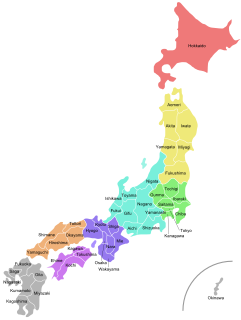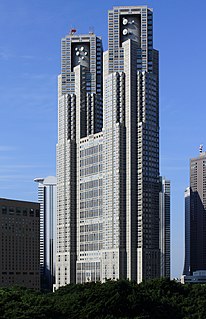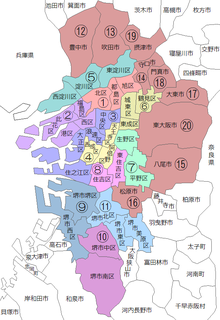Related Research Articles

Japan is divided into 47 prefectures, which rank immediately below the national government and form the country's first level of jurisdiction and administrative division. They include 43 prefectures proper, two urban prefectures, one "circuit" or "territory" and one metropolis. In 1868, the Meiji Fuhanken sanchisei administration created the first prefectures to replace the urban and rural administrators in the parts of the country previously controlled directly by the shogunate and a few territories of rebels/shogunate loyalists who had not submitted to the new government such as Aizu/Wakamatsu. In 1871, all remaining feudal domains (han) were also transformed into prefectures, so that prefectures subdivided the whole country. In several waves of territorial consolidation, today's 47 prefectures were formed by the turn of the century. In many instances, these are contiguous with the ancient ritsuryō provinces of Japan.

Special wards are a special form of municipalities in Japan under the 1947 Local Autonomy Law. They are city-level wards: primary subdivisions of a prefecture with municipal autonomy largely comparable to other forms of municipalities.

Tokyo City was a municipality in Japan and part of Tokyo-fu which existed from 1 May 1889 until its merger with its prefecture on 1 July 1943. The historical boundaries of Tokyo City are now occupied by the Special Wards of Tokyo. The new merged government became what is now Tokyo, also known as the Tokyo Metropolis, or, ambiguously, Tokyo Prefecture.
The Japanese political process has three types of elections: general elections to the House of Representatives held every four years, elections to the House of Councillors held every three years to choose half of its members, and local elections held every four years for offices in prefectures and municipalities. Elections are supervised by Election Administration Commissions at each administrative level under the general direction of the Central Election Management Council, an extraordinary organ attached to the Ministry of Internal Affairs and Communications (MIC). The minimum voting age in Japan's non-compulsory electoral system was reduced from twenty to eighteen years in June 2016. Voters must satisfy a three-month residency requirement before being allowed to cast a ballot.

The Tokyo Metropolitan Government is the government of the Tokyo Metropolis. One of the 47 prefectures of Japan, the government consists of a popularly elected governor and assembly. The headquarters building is located in the ward of Shinjuku. The metropolitan government administers the special wards, cities, towns and villages that constitute part of the Tokyo Metropolis. With a population closing in on 14 million living within its boundaries, and many more commuting from neighbouring prefectures, the metropolitan government wields significant political power within Japan.
Kunio Hiramatsu was the mayor of Osaka in Japan. He was elected in 2007 with centre-left support from the Democratic Party of Japan (DPJ), People's New Party and the Social Democratic Party, defeating the centre-right supported incumbent Jun'ichi Seki by 50,000 votes.

Tōru Hashimoto is a Japanese TV personality, politician and lawyer. He was the mayor of Osaka city and is a member of Nippon Ishin no Kai and the Osaka Restoration Association. He is one of Japan's leading right-wing japanese nationalist and conservative-populist politicians.

The Osaka Restoration Association, also referred to as One Osaka, is a regional political party in Osaka Prefecture, Japan. Founded in 2010 by then-Governor Tōru Hashimoto, its main platform is pursuing the Osaka Metropolis plan of merging the prefecture and some of its cities into "One Osaka" and reducing overlapping bureaucratic organizations of Osaka Prefecture and the city of Osaka.
This article lists events in 2011 in Japan.
The 17th unified local elections in Japan took place in April 2011. In the first phase on April 10, 2011 12 governors, 41 prefectural assemblies as well as five mayors and 15 assemblies in cities designated by government ordinance were elected. In the second phase on April 24, 2011 mayors and/or assemblies in hundreds of cities, cities of Tokyo, towns and villages were up for election. Additionally, a by-election for the National Diet was held in Aichi on April 24.
The 16th unified local elections in Japan took place in April 2007. In the first phase on April 8, 2007 13 governors, 44 prefectural assemblies as well as four mayors and 15 assemblies in cities designated by government ordinance were elected. In the second phase on April 22, 2007 mayors and/or assemblies in hundreds of cities, special wards, towns and villages were up for election. Additionally, by-elections for the national Diet were held in Fukushima and Okinawa on April 22.
Politics of Kanagawa, as in all prefectures of Japan, takes place in the framework of local autonomy that is guaranteed by the Constitution and laid out in the Local Autonomy Law. The administration is headed by a governor directly elected by the people every four years in first-past-the-post elections. Legislation, the budget and the approval of personnel appointments, including the vice governors, are handled by the prefectural assembly that is directly elected by the people every four years by single-non transferable vote.
The politics of Tokyo City, as the capital of the Empire of Japan, took place under special regulations that limited its local autonomy compared to other municipalities in Japan. In 1943, the city's independent institutions were eliminated altogether under the authoritarian Tōjō cabinet and the administration was absorbed by the appointed government of Tokyo prefecture.

The Osaka Metropolis Plan or Osaka Metropolis was a plan to transform Osaka Prefecture from a fu, an urban prefecture, into a to, a metropolis. Under the initially envisioned plan, Osaka city, Sakai city, and other surrounding cities in Osaka prefecture, were to be dissolved and – similarly to Tokyo urban wards within Tokyo – subdivided into special wards that have a status as municipalities but leave some municipal tasks and revenues to the prefectural administration. As political resistance grew, notably the opposition to the plan in Sakai city expressed in the 2013 mayoral election, the concrete plan was reduced to, at least as a first step, abolish only Osaka city. As in Tokyo, the metropolis would have continued to include all other municipalities of the prefecture and serve as prefectural government for them.
Politics of Osaka, as in all 47 prefectures of Japan, takes place in the framework of local autonomy that is guaranteed by chapter 8 of the Constitution and laid out in the Local Autonomy Law. The administration is headed by a governor directly elected by the people every four years in first-past-the-post elections. Legislation, the budget and the approval of personnel appointments, including the vice governors, are handled by the prefectural assembly that is directly elected by the people every four years by single-non transferable vote.

Ichirō Matsui is a Japanese politician who is the current mayor of Osaka, leader of the Osaka Restoration Association (ORA) and one of the presidents of Nippon Ishin no Kai alongside Toranosuke Katayama.

Hirofumi Yoshimura is a Japanese politician currently serving as the Governor of Osaka Prefecture. He assumed office in April 2019.
The 2015 Hyōgo prefectural election was an election for the Hyogo Prefectural Assembly held on 12 April 2015 as part of the 2015 unified local elections in Japan. The election saw the number of assembly members reduced from 89 to 87 and the number of electoral districts reduced from 41 to 40. Voting was held in 23 districts and representatives for the remaining 17 districts were elected unopposed. The election was held in the wake of the political expenses scandal that was exposed in July 2014 involving multiple assembly members and was notable for former assemblyman Ryutaro Nonomura's outburst of uncontrolled sobbing at a news conference.

Prefectural elections for the Tokyo Metropolitan Assembly were held on 2 July 2017. The 127 members were elected in forty-two electoral districts, seven returning single members elected by first-past-the-post, and thirty-five returning multiple members under single non-transferable vote. Four districts had their magnitude adjusted in this election to match population changes.

The Osaka City Council is the legislature of Osaka City. It is responsible for the "enactment, amendment and repeal of ordinances, budgetary decisions, approval of account settlements, matters of financial importances including acquisition and disposal of city assets, and others." The assembly has a regular membership 83 members, with 42 needed to form a majority.
References
- ↑ Osaka prefectural election commission: Electoral districts for the prefectural assembly
- ↑ The Japan Times, November 8, 2011: Stunner: JCP skips Osaka mayor race
- ↑ The Japan Times, February 8, 2012: [www.japantimes.co.jp/text/nn20120208a5.html Hashimoto group claims union tried to tip election]
- ↑ The Japan Times, May 27, 2012: Hashimoto stalks anthem foes
- ↑ The Japan Times, March 27, 2012: Old guard see despot in Hashimoto. Brash upstart recruiting legions, mainly male, to rock political boat
- ↑ The Japan Times Editorial, December 1, 2011: Populist storm in Osaka
- ↑ Asahi Shimbun, AJW (Asia & Japan Watch), March 3, 2012: Critics say 'Hashism' is a symptom of the degradation of politics Archived 2012-07-07 at archive.today
- ↑ The Economist, January 28, 2012: Generational warfare. Two rival political visions emerge for reviving Japan. Will they clash?
- ↑ Osaka City government: Historical mayors and vice-mayors
- ↑ Osaka City Council: Members by parliamentary group
- ↑ Osaka City Council: President and Vice President